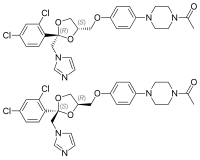
Photo from wikipedia
Posaconazole is more active than fluconazole against Candida albicans in vitro and is approved for the treatment of oropharyngeal candidiasis but not for that of invasive candidiasis (IC). Here, we… Click to show full abstract
Posaconazole is more active than fluconazole against Candida albicans in vitro and is approved for the treatment of oropharyngeal candidiasis but not for that of invasive candidiasis (IC). Here, we explored the efficacy of posaconazole against C. albicans in an in vitro pharmacokinetic/pharmacodynamic (PK/PD) model of IC and determined the probability of pharmacodynamic target attainment for the oral solution and intravenous (i.v.)/tablet formulations. ABSTRACT Posaconazole is more active than fluconazole against Candida albicans in vitro and is approved for the treatment of oropharyngeal candidiasis but not for that of invasive candidiasis (IC). Here, we explored the efficacy of posaconazole against C. albicans in an in vitro pharmacokinetic/pharmacodynamic (PK/PD) model of IC and determined the probability of pharmacodynamic target attainment for the oral solution and intravenous (i.v.)/tablet formulations. Three clinical C. albicans isolates (posaconazole MICs, 0.008 to 0.25 mg/liter) were studied in the in vitro PK/PD dilution model simulating steady-state posaconazole PK. The in vitro exposure-effect relationship, area under the 24-h free drug concentration curve (fAUC0–24)/MIC, was described and compared with in vivo outcome in animals with IC. PK/PD susceptibility breakpoints and trough levels required for optimal treatment were determined for EUCAST and CLSI 24-h/48-h (CLSI24h/CLSI48h) methods using the fAUC0–24/MIC associated with half-maximal activity (EI50) and Monte Carlo simulation analysis for oral solution (400 mg every 12 hours [q12h]) and i.v./tablet formulations (300 mg q24h). The in vitro mean (95% confidence interval [CI]) EI50 was 330 (183 to 597) fAUC0–24/MIC for CLSI24h and 169 (92 to 310) for EUCAST/CLSI48h methods, which are close to the near-stasis in vivo effect. The probability of target attainment for EI50 was estimated; for the wild-type isolates (MIC ≤ 0.06 mg/liter), it was low for the oral solution and higher than 95% for the i.v./tablet formulations for the EUCAST/CLSI48h methods but not for the CLSI 24-h method. Non-wild-type isolates with EUCAST/CLSI48h MICs of 0.125 and 0.25 mg/liter would require trough levels of >1.2 and >2.4 mg/liter, respectively. Posaconazole i.v./tablet formulations may have a role in the therapy of invasive infections by wild-type C. albicans isolates, provided that a steady state is reached quickly. A PK/PD susceptibility breakpoint at the epidemiological cutoff (ECV/ECOFF) of 0.06 mg/liter was determined.
Journal Title: Antimicrobial Agents and Chemotherapy
Year Published: 2021
Link to full text (if available)
Share on Social Media: Sign Up to like & get
recommendations!